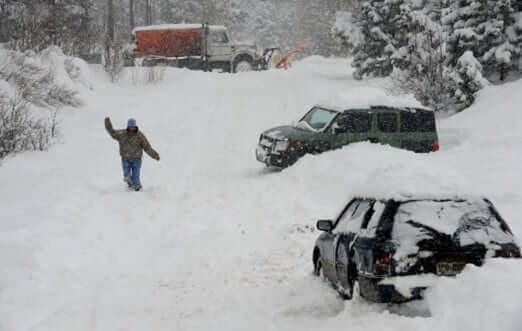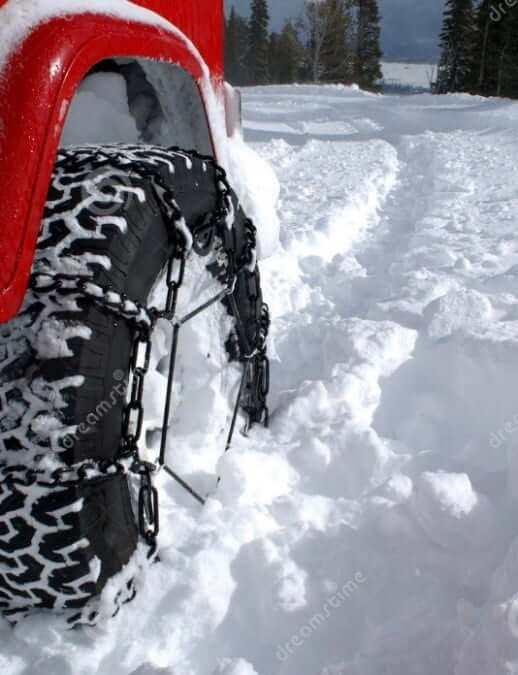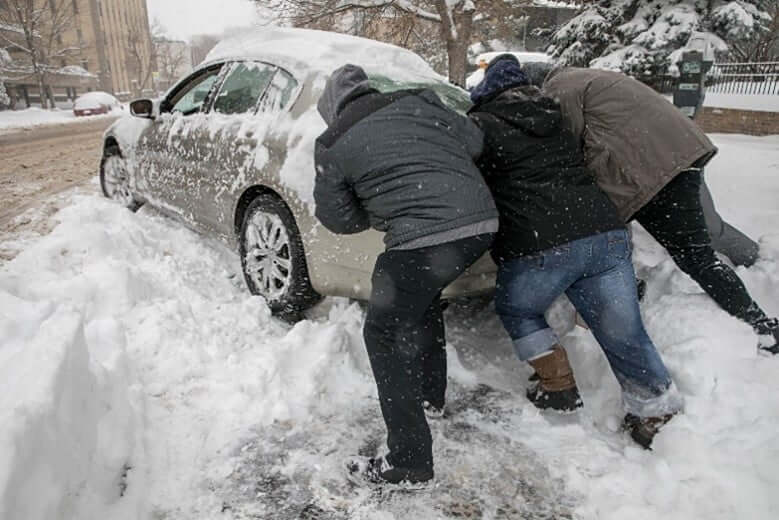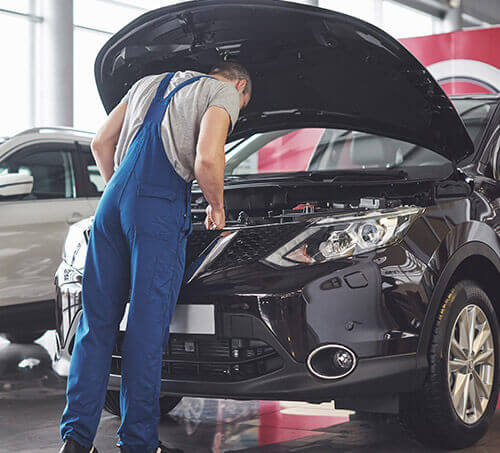
As Colorado digs itself out of yet another historic snowstorm, vehicle owners find themselves driving on streets with a foot or more of heavy snow. While winter driving presents its own set of unique challenges to the driver, it is important to remember that your vehicle can also suffer some serious injury as a result of heavy snow.
Suspension, alignment, battery discharge, and body damage are common issues relating to heavy snow. Yet the most problematic is adverse impacts to the drivetrain and especially the transmission and transfer case. As you shovel your car or truck out of the snowbank it is stuck in, consider the following as you get back on the road!
Traction and Your Drivetrain
When you are driving in heavy snow, the snow is getting packed up under your vehicle. Even for 4WD trucks and SUVs that have higher clearance, it isn’t long before you are starting to get high centered. As you lose traction, your natural inclination is to accelerate in order to keep your forward momentum going. Your wheels are spinning much faster than normal as you find yourself slowing down, so you step on the gas pedal in order to keep moving. Alternatively, you may find yourself stuck and start spinning the tires as you try to get your vehicle moving again. As you are doing this, a number of very dangerous factors are coming into play.
Whether or not you are able to get moving, those spinning tires mean that your transmission and drivetrain are working at a level far beyond normal operating levels. You are generating tremendous heat inside of the transmission and the differential as those tires are spinning at speeds your vehicle wasn’t designed for. Automatic transmission fluid is extremely sensitive to heat. As the transmission fluid heats up, oxygen begins to integrate with the fluid in a process called oxidation. Oxidation over time is normal and is the reason that you (hopefully!) get your transmission fluid changed at regular intervals. However, we are now talking about extremely rapid oxidation happening as the internal temperature increases while spinning those tires.
For every 18 degrees of temperature increase in your transmission fluid, the oxidation rate of the fluid doubles and its service life is cut in half. When a transmission is operating under normal conditions of 180 degrees or less, your transmission fluid will likely last 60,000 miles in good condition. As your tires are spinning wildly while you try to overcome the heavy snow you are driving in, the temperature inside of that transmission is climbing and damage is starting to occur. It won’t take long for that transmission fluid to go beyond 260 degrees and your transmission might have only minutes of life left. Once the heat becomes severe, soft or “wearable” parts (seals, gaskets, clutches, etc.) inside of the transmission degrade and hard parts begin to warp. You might avoid getting stuck, but you have just done damage inside of that transmission that could cost several thousand dollars to repair!
Then it is important to consider what happens when the tires catch traction again. You’ve been spinning those tires as fast as you can to get unstuck, and they are rotating at speeds equivalent to driving at 100+ miles an hour. Then suddenly they find traction and stick; all of that force is instantaneously transferred to the transmission, differential, and axles. The sudden torque applied to these components is far beyond what they were designed for, and it can result in a catastrophic failure. Gears and sprags inside of the transmission can let go, planetary gears and spindles can break in the differential, and axles can snap under the sudden load. You’ve put load on your vehicle that is the equivalent of putting it in neutral, accelerating to 5000 rpm, then putting the transmission into gear. Race cars are built for that kind of abuse, but your car, truck or SUV sure isn’t! Even without an immediate failure, parts can develop fractures or bend leading to dormant damage waiting to rear its head weeks or months down the road.



It’s also very important that you are cautious when trying to “rock” your vehicle when it is stuck, especially if you have an automatic transmission. Rapidly shifting between drive and reverse in order to get unstuck seems like a sound strategy, but you are risking very serious damage to your transmission. It is unbelievably hard on a transmission to shift into reverse while the vehicle is moving forward and shift into drive while the vehicle is moving backwards. When the torque load is moving forward and is suddenly reversed (or vice versa), you are putting a phenomenal load on the hard parts of the transmission. This doesn’t break down the soft parts previously referenced but rather causes the catastrophic failure of the hard parts (shafts, sprags, gears, bands, drums) that are the most expensive parts inside of the transmission. That rocking back and forth might get you unstuck from the snow, but you might get stuck with an expensive bill to rebuild or replace that transmission! Make sure your vehicle comes to a stop BEFORE you shift the other way.
Another major component of the drivetrain is the transfer case. It is the component that allows power from the transmission to transfer itself from one axle to both axles. In heavy snow it is almost necessary for all four wheels to receive power to achieve the required traction and control to operate safely in snow. These systems were designed to operate in minor scenarios that could be slippery, however, heavy snow could put the transfer case at major risk as it distributes power to both axles at differing ratios. Four-wheel drive repair can be costly and can be minimized by avoiding deep snow and regularly servicing the fluid. Similarly, differential systems are designed to allow different wheels along the same axle to receive power and spin at different rates. Extreme situations with limited road control can put these systems at risk thereby requiring a driveline specialist to conduct differential repairs. The best option in terrible weather and deep snow is to stay off the roads unless necessary. This allows first responders a safer environment to work in and protects your vehicle and family from harm!
Other Factors to Consider
Even if you aren’t driving, having your vehicle sitting in deep snow can cause all kinds of other problems. When snow gets packed up around the transmission, it is very easy for water to seep inside of the transmission. Water inside of the transmission is a VERY bad thing! The clutches and bands inside of the transmission often use a water-based adhesive and will delaminate if water encounters them. This delamination will result in transmission failure and you will now be looking at a full rebuild in order to replace all of the soft parts that have been damaged. Water intrusion can also damage electronic components and the valve body where rust buildup renders transmission failure inevitable. The increased electrification of transmissions makes water intrusion particularly problematic.
Snow that gets packed up around the front suspension can freeze and limit travel, which can result in premature failure. Snow packed around the brakes can limit functionality, making it almost impossible to stop since the brake pads can’t make contact with the rotors. Emergency brakes that are set while sitting in snow can result in a frozen cable and make it challenging to release the brake when you need to drive. And finally, seals in the axles and other hydraulic systems will harden in the cold and can fail when introduced to the pressures of normal operation. In short, your vehicle is not designed to operate in the deep, heavy snow that we get in Colorado periodically!
If you have drivetrain damage from driving in the snow or just want to make sure your transmission, transfer case or differential are in good operating condition, contact Advanced Transmission Center at either of our locations and we’d be happy to help! Unlike dealerships or many independent repair shops, we are transmission specialists trained to fix issues related to a vehicle’s drivetrain. You can reach out to either location that is most convenient for you.
Additional Considerations
How does heavy snow affect my vehicle’s transmission and drivetrain?
Heavy snow can significantly increase the stress on your vehicle’s transmission and drivetrain as it struggles to move through or get unstuck from snow. This stress can lead to increased wear or even potential damage. Handling these situations with care by gently attempting to maneuver the vehicle without harsh acceleration can help minimize the risk of damage. It’s essential to be mindful of these challenges and approach them with patience to protect your vehicle’s critical components.
What should I do to prevent damage when my car is stuck in the snow?
When your car is stuck in the snow, avoid using aggressive methods such as spinning the tires at high speeds or rapidly shifting between gears, which can quickly lead to overheating and significant drivetrain damage. Instead, use gentle maneuvers and consider leveraging traction aids like sand or traction mats to help your vehicle gain grip safely. This approach can prevent unnecessary strain on your transmission and drivetrain, reducing the risk of costly repairs.
What steps should I take if I suspect snow driving has damaged my vehicle?
If after driving in heavy snow, you notice unusual noises or behaviors from your vehicle, or if it was subjected to particularly harsh conditions, consulting a transmission specialist as soon as possible is prudent. They can conduct a thorough assessment to determine any damage or wear that may have occurred and advise on the necessary repairs or preventative measures. Prompt attention to these signs can help avoid more significant issues down the line, ensuring your vehicle remains safe and reliable.
Advanced Transmission Center is a Colorado-owned and operated auto repair shop with locations in Denver / Lakewood and Westminster. ATC specializes in driveline issues such as automatic transmission repair, four wheel drive repair, clutch replacement, differentials, manual transmissions and CVT. As Colorado's first AAA approved shop our goal is to provide accurate, timely service with exceptional customer satisfaction. All of our technicians are certified in the latest makes and models and we are one of the few transmission repair shops with a nationwide warranty.



 Free Customer Towing Service
Free Customer Towing Service  Free TrueTest™ Inspection
Free TrueTest™ Inspection  Fast Transmission Services
Fast Transmission Services  Comprehensive Warranty in Denver
Comprehensive Warranty in Denver 

























